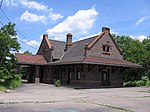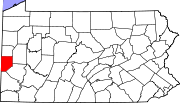Aliquippa, Pennsylvania
This article needs additional citations for verification. (May 2010) |
Aliquippa | |
|---|---|
City | |
 Franklin Avenue downtown | |
| Nickname(s): Quip | |
 Location in Beaver County and the U.S. state of Pennsylvania. | |
 Aliquippa Location in Beaver County and the U.S. state of Pennsylvania. | |
| Coordinates: 40°36′54″N 80°15′47″W / 40.61500°N 80.26306°WCoordinates: 40°36′54″N 80°15′47″W / 40.61500°N 80.26306°W | |
| Country | United States |
| State | Pennsylvania |
| County | Beaver |
| Settled | 1793 |
| Incorporated | 1894 |
| 1928 (borough) | |
| 1987 (city) | |
| Government | |
| • Type | City Council |
| Area | |
| • Total | 4.60 sq mi (11.91 km2) |
| • Land | 4.20 sq mi (10.87 km2) |
| • Water | 0.40 sq mi (1.04 km2) |
| Elevation | 850 ft (260 m) |
| Population (2010) | |
| • Total | 9,438 |
| • Estimate (2019)[2] | 8,844 |
| • Density | 2,107.72/sq mi (813.76/km2) |
| Time zone | UTC−5 (Eastern (EST)) |
| • Summer (DST) | UTC−4 (EDT) |
| ZIP Code | 15001 |
| FIPS code | 42-00820 |
| Website | City of Aliquippa website |
Aliquippa is a city in Beaver County in the U.S. state of Pennsylvania, located on the Ohio River in the western portions of the Pittsburgh Metropolitan Statistical Area. The population was 9,438 at the 2010 census.
History[]
Aliquippa was founded by the merger of three towns: Aliquippa, Woodlawn,[3] and New Sheffield.[4][5] There is no known direct connection between Seneca Queen Aliquippa and the city; rather, "Aliquippa" was one of several Indian names selected arbitrarily by the Pittsburgh and Lake Erie Railroad in 1878 for stations along its route.[5] The oldest church within the current boundaries of Aliquippa is Mt. Carmel Presbyterian Church (formerly White Oak Flats Presbyterian Church), established about 1793 in the New Sheffield region on Brodhead Road.[5] Aliquippa is best known as the location of a productive steel mill that the Jones and Laughlin Steel Company constructed there along the Ohio River beginning in 1905. Employment at the facility sustained a population of 27,023 in 1940.[5]

The mill closed in 1984 during the collapse of the steel industry during the 1980s, and was demolished in 1988. This major economic loss alongside suburbanization caused a major population loss through the end of the 20th century. Many of the city's businesses have left since the closing of the mill. This has left the city economically depressed, with the crime rate dramatically rising over time.
Aliquippa was formally named a city in 1987 by the Aliquippa Borough Council.
The B.F. Jones Memorial Library is a historical landmark of the community.
Demographics[]
| Historical population | |||
|---|---|---|---|
| Census | Pop. | %± | |
| 1900 | 620 | — | |
| 1910 | 1,743 | 181.1% | |
| 1920 | 2,931 | 68.2% | |
| 1930 | 27,116 | 825.1% | |
| 1940 | 27,023 | −0.3% | |
| 1950 | 26,132 | −3.3% | |
| 1960 | 26,369 | 0.9% | |
| 1970 | 22,277 | −15.5% | |
| 1980 | 17,094 | −23.3% | |
| 1990 | 13,374 | −21.8% | |
| 2000 | 11,734 | −12.3% | |
| 2010 | 9,438 | −19.6% | |
| 2019 (est.) | 8,844 | [2] | −6.3% |
| Sources:[6][7][8][9] | |||
As of the 2010 census, the city had 9,438 people. The city was 57.6% White, 38.6% Black or African American, 0.1% Native American, 0.4% Asian, and 2.8% were two or more races. 1.3% of the population was of Hispanic or Latino ancestry.[10]
As of the census[9] of 2000, there were 11,734 people, 5,124 households, and 3,176 families residing in the city. The population density was 2,867.7 people per square mile (1,107.7/km2). There were 5,843 housing units at an average density of 1,428.0 per square mile (551.6/km2). The racial makeup of the city was 62.59% White, 35.52% African American, 0.07% Native American, 0.18% Asian, 0.03% Pacific Islander, 0.18% from other races, and 1.43% from two or more races. Hispanic or Latino of any race were 1.00% of the population.
There were 5,124 households, out of which 24.4% had children under the age of 18 living with them, 35.7% were married couples living together, 21.6% had a female householder with no husband present, and 38.0% were non-families. Of all households 35.0% were made up of individuals, and 17.1% had someone living alone who was 65 years of age or older. The average household size was 2.27 and the average family size was 2.92.
In the city, the population was spread out, with 23.5% under the age of 18, 7.6% from 18 to 24, 25.5% from 25 to 44, 20.9% from 45 to 64, and 22.5% who were 65 years of age or older. The median age was 40 years. For every 100 females, there were 82.7 males. For every 100 females age 18 and over, there were 77.2 males.
The median income for a household in the city was $25,113, and the median income for a family was $34,003. Males had a median income of $27,954 versus $21,358 for females. The per capita income for the city was $13,718. About 17.7% of families and 21.7% of the population were below the poverty line, including 36.3% of those under age 18 and 10.9% of those age 65 or over.
Surrounding and adjacent neighborhoods[]
Aliquippa is entirely landlocked by Hopewell Township. Across the Ohio River, the city runs adjacent with, from north to south, the borough of Baden, Harmony Township and the borough of Ambridge which connects to Aliquippa via Ambridge-Aliquippa Bridge.
Notable people[]
This article's list of residents may not follow Wikipedia's verifiability policy. (October 2019) |
- Gust Avrakotos, Central Intelligence Agency (CIA) operative
- Jon Baldwin, National Football League (NFL) player
- Tommie Campbell, NFL player
- Daniel Chamovitz, biologist, author of What a Plant Knows, and President of Ben Gurion University of the Negev[11]
- Francis J. D'Eramo, Judge at the United States Virgin Islands Superior Court on St. Croix.[12]
- Mike Ditka, NFL Pro Football Hall of Fame player and coach
- Tony Dorsett, NFL Pro Football Hall of Fame player
- Kenny Easterday, star of the Canadian movie Kenny (1988)
- Ivor Parry Evans, base commander, Walker AFB
- Tito Francona, Major League Baseball (MLB) player
- James Frank, the first African-American president of the NCAA [13]
- Sean Gilbert, NFL player
- Frank Gnup, Canadian football player and coach
- Nate Guenin, National Hockey League (NHL) player
- Frank Hribar, NFL player
- Ty Law, NFL Pro Football Hall of Fame player
- Joe Letteri, visual imaging artist
- Henry Mancini, Grammy and Oscar-winning music composer ("Moon River" and "The Pink Panther Theme"), born in Cleveland, raised in Aliquippa
- Pete Maravich, Basketball Hall of Fame player
- Press Maravich, basketball coach
- Demetria Martinez, poet and author
- Felicia Mason, author
- Doc Medich, MLB pitcher
- , NFL coach [14]
- Paul Posluszny, NFL player
- Darrelle Revis, NFL player
- Aaron Shust, contemporary Christian music artist
- Curt Singer, NFL player [15]
- Jesse Steinfeld, Surgeon General of the United States
- Pete Suder, MLB player
- Edward Surratt, Confessed serial killer and rapist from the 1970s.
- Tim Shaffer, sprint car driver
- Robert Wykes, classical flautist
- , Professional Basketball Player For Santo Andre in Portugal, IUP Alumnus [16]
Education[]
The city's residents are served by the Aliquippa School District. Children may also choose to attend a public charter school: Beaver Area Academic Charter School, Lincoln Park Performing Arts Charter School, or the Pennsylvania Cyber Charter School, a statewide public charter school based in Midland.[17]
Private schools[]
- Bethel Christian School
- Hope Christian Academy
- Sylvania Hills Christian
See also[]
- List of cities and towns along the Ohio River
References[]
- ^ "2019 U.S. Gazetteer Files". United States Census Bureau. Retrieved July 28, 2020.
- ^ Jump up to: a b "Population and Housing Unit Estimates". United States Census Bureau. May 24, 2020. Retrieved May 27, 2020.
- ^ "Woodlawn, Beaver County, Pennsylvania". Geographic Names Information System. United States Geological Survey. Retrieved May 19, 2018.
- ^ "New Sheffield, Beaver County, Pennsylvania". Geographic Names Information System. United States Geological Survey. Retrieved May 19, 2018.
- ^ Jump up to: a b c d "Aliquippa". Beaver County Bicentennial Atlas. 2002. Archived from the original on May 2, 2015. Retrieved May 19, 2018.
- ^ "1940 US Census". Archived from the original on March 27, 2010. Retrieved December 12, 2017.
- ^ "1960 US Census". Archived from the original on January 23, 2013. Retrieved December 12, 2017.
- ^ 1990 US Census
- ^ Jump up to: a b "U.S. Census website". United States Census Bureau. Retrieved January 31, 2008.
- ^ USA Today Census profile
- ^ https://in.bgu.ac.il/en/Pages/management/president.aspx. Retrieved June 27, 2019. Missing or empty
|title=(help) - ^ Current Judges
- ^ "Little Known Black History Fact: Dr. James Frank". April 8, 2014. Retrieved January 26, 2020.
- ^ https://www.buccaneers.com/team/coaches-roster/anthony-piroli
- ^ https://www.profootballarchives.com/players/sing00200.html
- ^ https://www.thepenn.org/sports/from-indiana-to-the-pros-iup-athletes-make-it-to-the-professional-level/article_d8f74012-5ac2-11eb-9647-cf762e763648.html
- ^ Pennsylvania Department of Education, EdNA - Beaver County Schools, April 2011
- Feature in Sports Illustrated in January 2011, http://sportsillustrated.cnn.com/vault/article/magazine/MAG1181210/index.htm
External links[]
- Aliquippa, Pennsylvania
- Cities in Pennsylvania
- Pennsylvania populated places on the Ohio River
- Populated places established in 1793
- Pittsburgh metropolitan area
- Cities in Beaver County, Pennsylvania
- Company towns in Pennsylvania
- 1793 establishments in Pennsylvania




